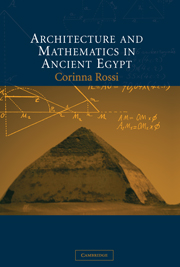Book contents
- Frontmatter
- Contents
- List of illustrations
- List of tables
- Preface
- Acknowledgments
- List of abbreviations
- Part I Proportions in ancient Egyptian architecture
- Part I Ancient Egyptian sources: construction and representation of space
- Part III The geometry of pyramids
- Conclusion to Part III: Interpreting the slope of pyramids
- An overview
- Appendix: List of Old and Middle Kingdom true pyramids
- Bibliography
- Index
An overview
Published online by Cambridge University Press: 27 February 2010
- Frontmatter
- Contents
- List of illustrations
- List of tables
- Preface
- Acknowledgments
- List of abbreviations
- Part I Proportions in ancient Egyptian architecture
- Part I Ancient Egyptian sources: construction and representation of space
- Part III The geometry of pyramids
- Conclusion to Part III: Interpreting the slope of pyramids
- An overview
- Appendix: List of Old and Middle Kingdom true pyramids
- Bibliography
- Index
Summary
Paradoxically, the faults and merits of many theories on the proportions in ancient Egyptian architecture share a common origin: the continuity between ancient Egypt and the Western culture. Listing the faults of some nineteenth- and twentieth-century interpretations of the proportions in the ancient Egyptian architecture is very easy. The desire to find links with the past led at times to the attribution of later meanings to earlier documents and also to the misuse of mathematical concepts, while legitimate sources such as ancient texts or drawings were set aside or ignored. Finding geometrical connections in (a drawing on a sheet of paper that represents the plan of) an Egyptian monument proved to be relatively easy, after all.
However, this kind of study also has some merits. The focus on continuity with the past, while sometimes admittedly exaggerated, encouraged research on transmission of knowledge from culture to culture. Egypt certainly had an influence on Greece (and obviously vice-versa), and even if by means of re-interpreted or re-invented forms, it continued to influence the development of Western culture for centuries. It is important to make a distinction between what ancient Egypt was (that is, what we reconstruct today on the basis of the available archaeological and textual sources) and what ‘ancient Egypt’ meant to Francesco Colonna, author of the fantastic novel Hypnerotomachia Poliphili (late fifteenth century); to the Rosacrucians and their ideals; to Athanasius Kircher, author of the Oedipus Aegyptiacus and other studies (seventeenth century); to Cagliostro, the Freemasons, and their symbolism; to Giovan Battista Piranesi and his engravings; to Johann Wolfgang von Goethe, collector of aegyptiaca (second half of the eighteenth century); to Friedrick Schinkel, author of the scenography for Mozart's The Magic Flute (1815); and to the spectators of Giovanni Belzoni's exhibition of Egyptian mummies (1842).
- Type
- Chapter
- Information
- Architecture and Mathematics in Ancient Egypt , pp. 239 - 241Publisher: Cambridge University PressPrint publication year: 2004



